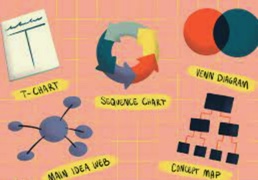Literacy Series
This series offers a variety of online courses designed to help teachers work with students to improve in all areas of literacy including practical classroom strategies, best practices and interventions for struggling students.
Reading Foundations

Course Length: 6 hrs. 45 min.
The Big 6: Essential Components of Reading Instruction
Take a moment to think about your literacy block and the time you devote to teaching or doing activities that support each of the six components of reading; phonemic awareness, phonics, fluency, vocabulary, reading comprehension, and oral language. In this course, you will be challenged to think about each component and what you’re doing to build skills in each area. Gain new strategies you can use tomorrow.

Course Length: 3 hrs.
Reading Comprehension - Elementary Best Practices
Reading is everywhere. But, there is a vast difference between the act of reading and the act of comprehending what is read. In this course, you will learn the differences between the two and will be introduced to strategies that will help you provide your students with the knowledge, skills and experiences necessary in becoming competent and enthusiastic readers. You will identify key components and teaching strategies of Reading Comprehension and will learn how to incorporate these strategies into your curriculum, creating a learning environment that will help make reading more enjoyable, fun, innovative and, ultimately, bring greater success to your students academically across all subject areas.

Course Length: 3 hrs.
Reading Comprehension - Secondary Best Practices
Shouldn’t they already know how to read? Beginning in middle school, there is a defined shift in instruction from “learning to read” to “reading to learn.” But an overwhelming number of middle and high school students are lacking the academic literacy skills that are needed to keep up with the high demands of increasingly diverse and challenging texts across all subject areas. This course will focus on secondary reading comprehension and literacy strategies for secondary classrooms. You will explore reading comprehension strategies, practices, and resources that can be utilized at the secondary level, across the curriculum, in all subject areas. You will hear from specialists in their fields and watch captivating videos of real teachers demonstrating how they incorporate literacy instruction into their content area lessons.

Course Length: 3 hrs. 30 mins.
Oral Language: The Key to a Strong Literacy Foundation
Separating oral language, reading and writing is almost impossible because they work together and in part, develop together. An increased focus on oral language skills will benefit both ELL students and native English speakers. This course will highlight the importance of oral language for literacy, academic vocabulary development and practical language strategies. Let’s get students talking!

Course Length: TBD hrs.
Phonological Awareness
Phonological awareness supports students’ understanding that words are made up of a series of discrete sounds. But what does phonological awareness even mean? And how are you supposed to teach these skills? In this course, you will learn more about what phonological awareness means and the importance of teaching these skills that will provide students with a solid foundation for reading success.

Course Length: TBD hrs.
Phonics
Phonics is a critical component to reading as students learn to map sounds onto letters and spellings. This course will explore the importance of explicit phonics instruction as a foundation to reading. You will also learn classroom strategies for teaching phonics in a systematic, explicit way that will have a positive impact on students’ growth in reading.

Course Length: TBD hrs.
Fluency
When students lack phonological awareness and are heavily focused on decoding, they will not be able to read fluently. As a result, they will also continue to struggle with comprehension. This course will focus on the critical importance of building reader fluency. You will learn skills and strategies for teaching students to recognize words automatically and group words quickly to gain meaning from what they read.

Course Length: TBD hrs.
Vocabulary Builders
Vocabulary instruction involves more than just looking words up or using them in sentences. Explicit vocabulary instruction has been proven highly effective by the National Reading Panel and learning new vocabulary is an on-going process. This course will provide you with tips and strategies for explicitly teaching vocabulary.

Course Length: TBD hrs.
Spelling
Spelling and reading are connected in ways you may not have realized. In the past, many of us memorized a list of spelling words each week and were tested on those lists each Friday. That was just how spelling was taught. But teaching spelling involves many components of teaching reading, like phonological awareness and orthographic mapping. In this course, we will further explore the connection between spelling and reading. We will also look at strategies for explicit instruction of spelling to support students’ growth in both reading and spelling.

Course Length: 2 hrs.
Questioning Strategies for Guided Reading
As an elementary teacher, do you sometimes feel like you’re in literacy limbo, sandwiched between lower elementary students who are learning to read, and the upper elementary students who are reading to learn? Do you feel like you’re juggling guided reading and skill groups constantly as you strive to meet the needs of all learners, from fluent to proficient? In this course, you will gain new strategies and practical resources for creating prompts and targeted questions to bolster comprehension.
Best Practices and Classroom Strategies

Course Length: 2 hrs. 25 mins.
Dig Deep into the Daily Five
In classrooms that implement the Daily 5, students select from five authentic reading and writing choices and work independently while the teacher facilitates whole-group, small-group or one-on-one lessons. These choices include 1) Read to Self, 2)Work on Writing, 3) Read to Someone, 4) Listen to Reading, and 5) Word Work. In this course, you will explore each choice and examine the benefits to implementing The Daily 5. Help students develop independence and improve literacy achievement!

Course Length: 7 hrs. 30 mins.
Creating an Effective Balanced Literacy Program
Research tells us that increasing writing instruction will have a significant impact on student achievement. Do you need some ideas for combining all the elements of guided, independent and shared reading and writing to create a literacy program that works for your students? This course will provide powerful real classroom examples of teachers in action. You will also be introduced to the “craft of writing” through a workshop by literacy expert, Marcia Freeman.

Course Length: 3 hrs. 30 mins.
Understanding Literacy Stages and Assessment
As students pass through the stages of literacy, the elements in a literacy program should adapt and change to complement student growth. In this course, you will learn the basics of literacy development and the balanced literacy diet. Explore assessment and progress monitoring with an emphasis on oral reading fluency.
Writing Strategies / Composition

Course Length: 2 hrs. 45 mins.
Every Child a Writer: How to Use Writer’s Workshop Effectively‐ Elementary version
If we know from experience that a workshop approach to the teaching of writing works well for aspiring professional writers, why shouldn’t we use this approach in our classrooms? In this course, you will learn how to launch a writer’s workshop and maintain momentum throughout the school year. Become a writing coach who guides your student authors as they explore their craft instead of spending the majority of class time on spelling tests, grammar worksheets, handwriting practice, and other isolated sub-skills of writing.

Course Length: 2 hrs. 45 mins.
Every Child a Writer: How to Use Writer’s Workshop Effectively‐ Intermediate version
If we know from experience that a workshop approach to the teaching of writing works well for aspiring professional writers, why shouldn’t we use this approach in our classrooms? In this course, you will learn how to launch a writer’s workshop and maintain momentum throughout the school year. Become a writing coach who guides your student authors as they explore their craft instead of spending the majority of class time on spelling tests, grammar worksheets, handwriting practice, and other isolated sub-skills of writing.

Course Length: 4 hrs. 30 mins.
Visual Tools and Graphic Organizers
Be a virtual participant in a workshop hosted by David Hyerle. Explore tools such as webbing, graphic organizers and concept mapping and learn how these tools can be pulled together in a whole school environment. Through taking this course, you will learn how to use visual tools to facilitate literacy and develop an understanding of how these supports can help students make sense of and retain information from the content you teach.
Interventions

Course Length: 5 hrs.
Working With Struggling Readers
Many children struggle with reading and the US literacy rate is declining. The facts are startling. This course will help you gain insight into the science of reading, assessment options and strategies to support struggling readers.

Course Length: 5 hrs. 30 mins.
Why Boys? Closing the Gender Literacy Gap
All educators share the common goal of providing equitable learning opportunities for every student in the classroom. Providing equitable opportunities for girls is a familiar topic; providing them for boys is a relatively recent issue, but one that is appearing with increasing urgency on education agendas around the world. Why? An increasing volume of evidence indicates that gender is a significant factor in both choice of reading materials and reading achievement for boys and girls. This course will explore the issue and provide 7 strategies for engaging boys and increasing reading and writing skills.

Course Length: 2 hrs. 30 mins.
An Introduction to Dyslexia Accommodations and Modifications
For many of us, reading is as automatic as breathing. But for the millions of students with dyslexia, reading is a difficult task that poses constant academic and emotional challenges. In addition to quality intervention, students with dyslexia benefit from classroom accommodations that take into account their unique processing challenges and allow them to demonstrate their content understanding and access the curriculum with more ease. Modifications are also often needed. In this course, you will explore the difference between accommodations and modifications and be introduced to new strategies that will benefit your students.

Course Length: 4 hrs. 30 mins.
Four Key Strategies for Students with Dyslexia
Dyslexia is a lifelong condition. With proper help, many people with dyslexia can learn to read and write well. Early identification and treatment is the key to helping individuals with dyslexia achieve in school and in life. Schools can implement academic accommodations and modifications to help students with dyslexia succeed. Accommodations level the playing field for students with dyslexia...they do not give an unfair advantage. An accommodation can be the bridge between success and failure. In this course, you will review the signs of dyslexia and explore easy accommodations all teachers can make in their classrooms.

Course Length: 3 hrs.
6 Accommodations for Students with Dyslexia
While dyslexia is a life-long condition, early identification, support from a parent or teacher, and access to digital or audio books and other learning materials may help your child to improve their learning outcomes and be better prepared to successfully work around their learning disability. Research now demonstrates that when children with LD are given accessible instructional materials (often referred to as AIM) textbooks or learning materials that are delivered in audio and/or digital formats they can excel in school and also learn to enjoy reading. In this course, you will explore six key accommodations for students with dyslexia.

Course Length: 2 hrs. 30 mins.
Dyslexia in the Classroom
Individuals with dyslexia are unique and their challenges with reading, spelling, and/or speaking vary greatly from person to person.In this course, you will learn about the signs of dyslexia, common misconceptions and classroom strategies that can make a real difference. You will also be introduced to a multisensory approach to instruction and explore the need for a structured literacy program.